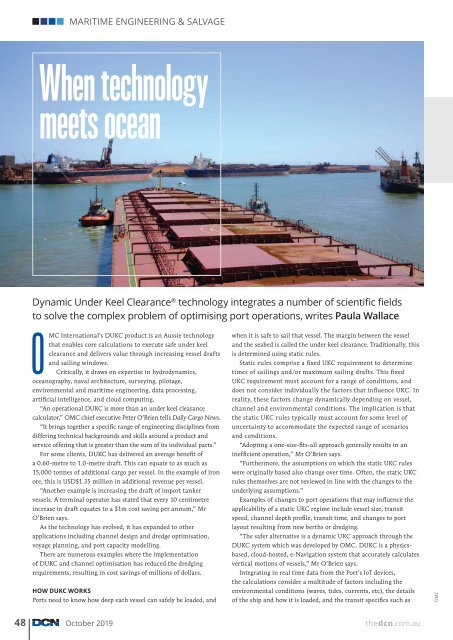DCN October Edition 2019
You also want an ePaper? Increase the reach of your titles
YUMPU automatically turns print PDFs into web optimized ePapers that Google loves.
MARITIME ENGINEERING & SALVAGE<br />
When technology<br />
meets ocean<br />
Dynamic Under Keel Clearance ® technology integrates a number of scientific fields<br />
to solve the complex problem of optimising port operations, writes Paula Wallace<br />
OMC International’s DUKC product is an Aussie technology<br />
that enables core calculations to execute safe under keel<br />
clearance and delivers value through increasing vessel drafts<br />
and sailing windows.<br />
Critically, it draws on expertise in hydrodynamics,<br />
oceanography, naval architecture, surveying, pilotage,<br />
environmental and maritime engineering, data processing,<br />
artificial intelligence, and cloud computing.<br />
“An operational DUKC is more than an under keel clearance<br />
calculator,” OMC chief executive Peter O’Brien tells Daily Cargo News.<br />
“It brings together a specific range of engineering disciplines from<br />
differing technical backgrounds and skills around a product and<br />
service offering that is greater than the sum of its individual parts.”<br />
For some clients, DUKC has delivered an average benefit of<br />
a 0.60-metre to 1.0-metre draft. This can equate to as much as<br />
15,000 tonnes of additional cargo per vessel. In the example of iron<br />
ore, this is USD$1.35 million in additional revenue per vessel.<br />
“Another example is increasing the draft of import tanker<br />
vessels. A terminal operator has stated that every 10 centimetre<br />
increase in draft equates to a $1m cost saving per annum,” Mr<br />
O’Brien says.<br />
As the technology has evolved, it has expanded to other<br />
applications including channel design and dredge optimisation,<br />
voyage planning, and port capacity modelling.<br />
There are numerous examples where the implementation<br />
of DUKC and channel optimisation has reduced the dredging<br />
requirements, resulting in cost savings of millions of dollars.<br />
HOW DUKC WORKS<br />
Ports need to know how deep each vessel can safely be loaded, and<br />
when it is safe to sail that vessel. The margin between the vessel<br />
and the seabed is called the under keel clearance. Traditionally, this<br />
is determined using static rules.<br />
Static rules comprise a fixed UKC requirement to determine<br />
times of sailings and/or maximum sailing drafts. This fixed<br />
UKC requirement must account for a range of conditions, and<br />
does not consider individually the factors that influence UKC. In<br />
reality, these factors change dynamically depending on vessel,<br />
channel and environmental conditions. The implication is that<br />
the static UKC rules typically must account for some level of<br />
uncertainty to accommodate the expected range of scenarios<br />
and conditions.<br />
“Adopting a one-size-fits-all approach generally results in an<br />
inefficient operation,” Mr O’Brien says.<br />
“Furthermore, the assumptions on which the static UKC rules<br />
were originally based also change over time. Often, the static UKC<br />
rules themselves are not reviewed in line with the changes to the<br />
underlying assumptions.”<br />
Examples of changes to port operations that may influence the<br />
applicability of a static UKC regime include vessel size, transit<br />
speed, channel depth profile, transit time, and changes to port<br />
layout resulting from new berths or dredging.<br />
“The safer alternative is a dynamic UKC approach through the<br />
DUKC system which was developed by OMC. DUKC is a physicsbased,<br />
cloud-hosted, e-Navigation system that accurately calculates<br />
vertical motions of vessels,” Mr O’Brien says.<br />
Integrating in real time data from the Port’s IoT devices,<br />
the calculations consider a multitude of factors including the<br />
environmental conditions (waves, tides, currents, etc), the details<br />
of the ship and how it is loaded, and the transit specifics such as<br />
OMC<br />
48 <strong>October</strong> <strong>2019</strong><br />
thedcn.com.au
















